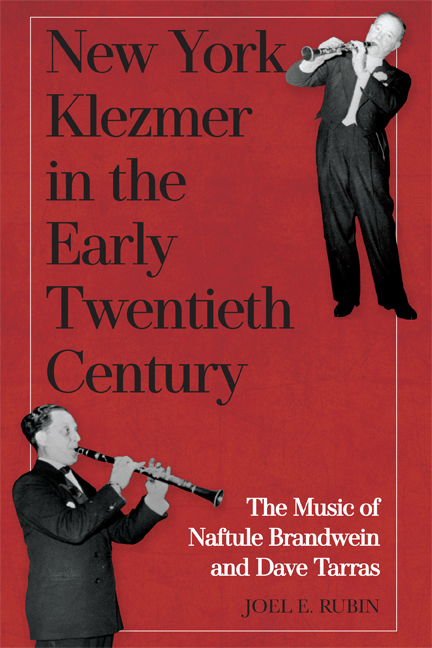Book contents
- Frontmatter
- Contents
- Acknowledgments
- List of Abbreviations
- Note on Orthography and Transliteration
- About the Companion Website
- Introduction: “If You Called Me A Klezmer Thirty-Five Years Ago …”
- 1 A Wedding in Town Was Like a Holiday: A Short History of Klezmorim in Europe
- 2 Klezmer in New York: Changing Meanings, Changing Contexts
- 3 A Kind of “Ethnomusicological Archive”: Commercial 78-rpm Recordings of Klezmer Music
- 4 A Single Field Irrespective of Origin: Polymusicality and Language, Aesthetics, Classification, and Transcription
- 5 “What Mattered Was What’s Happening with the Tune”: Modality and Compositional Processes
- 6 “The Little Things That They Do”: Ornaments and Performance Practice Techniques
- 7 “The Newest Bulgar Out That Everyone Played”: New York Klezmer after 1929
- Glossary
- Notes
- Bibliography
- Index
2 - Klezmer in New York: Changing Meanings, Changing Contexts
Published online by Cambridge University Press: 11 September 2020
- Frontmatter
- Contents
- Acknowledgments
- List of Abbreviations
- Note on Orthography and Transliteration
- About the Companion Website
- Introduction: “If You Called Me A Klezmer Thirty-Five Years Ago …”
- 1 A Wedding in Town Was Like a Holiday: A Short History of Klezmorim in Europe
- 2 Klezmer in New York: Changing Meanings, Changing Contexts
- 3 A Kind of “Ethnomusicological Archive”: Commercial 78-rpm Recordings of Klezmer Music
- 4 A Single Field Irrespective of Origin: Polymusicality and Language, Aesthetics, Classification, and Transcription
- 5 “What Mattered Was What’s Happening with the Tune”: Modality and Compositional Processes
- 6 “The Little Things That They Do”: Ornaments and Performance Practice Techniques
- 7 “The Newest Bulgar Out That Everyone Played”: New York Klezmer after 1929
- Glossary
- Notes
- Bibliography
- Index
Summary
Life in the Yiddish-Speaking Neighborhoods
The eastern European Jews arriving in New York—even those coming from large cities such as Warsaw or Odessa—encountered a radically different society than that which they had known previously. During the entire period from 1881 until the outbreak of World War II in 1939, however, American Jews did maintain various levels of contact with their relatives and communities in Europe and vice versa. During that period, the two worlds existed in parallel, with considerable interaction between them. This included the physical movements of klezmorim and other musicians back and forth as well as the distribution of sheet music and recordings, which enriched the musical worlds on both sides of the Atlantic. Over an approximately seventy-year period they developed a transitional culture in New York, borrowing elements from eastern Europe and the United States to create a unique amalgam of religious and secular aspects, “neither completely eastern European nor fully American.” They settled voluntarily in crowded immigrant quarters, in particular in the neighborhood in Lower Manhattan now known as the Lower East Side, which at its peak in 1910 claimed 542,061 inhabitants. Just as Jews had always lived alongside non- Jews in eastern European shtetls and cities, at no time did this neighborhood comprise Jews only. On the Lower East Side, Jewish settlement patterns suggested the “cultural, if not the physical, geography” of eastern Europe: Hungarians, Galicians, Romanians, and Russians all inhabited separate sections of the district. After 1910, the Lower East Side began to decline in size as Jews spread out to Harlem, the Bronx, and, facilitated by the construction of the Williamsburg and Manhattan bridges, new areas of Brooklyn such as Williamsburg and Brownsville. By the mid-1920s, Brooklyn had almost as many Jewish inhabitants as Manhattan and the Bronx taken together. Largely as a result of immigration, the overall Jewish population in New York increased from 80,000 in 1870 to 1,400,000 in 1915, creating the largest single concentration of Jews in history. The largest immigrant subgroup was Jews from imperial Russia, followed by Galicians, Hungarians, and Romanians. Moses Rischin depicts a variegated society on the Lower East Side, in which religious observance had become relaxed even among the older generation, with eastern European customs seeming “retrograde and uncouth.”
- Type
- Chapter
- Information
- New York Klezmer in the Early Twentieth CenturyThe Music of Naftule Brandwein and Dave Tarras, pp. 34 - 86Publisher: Boydell & BrewerPrint publication year: 2020



